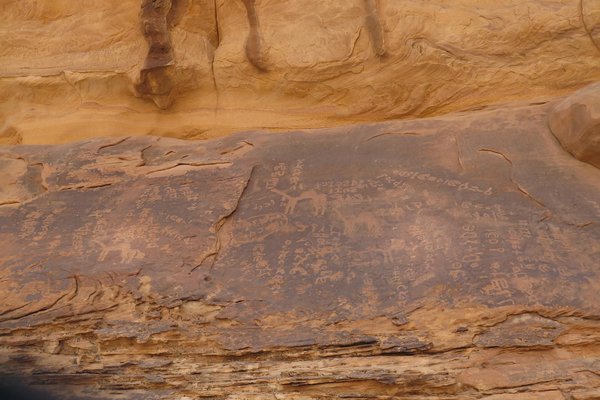Saudi Arabia
Rock Art in the Hail Region
Rock Art in the Hail Region of Saudi Arabia consists of two sites with petroglyphs and inscriptions.
The rock carvings date back to almost 10,000 years ago, when there was a valley here with flowing water which has now disappeared. Humans and animals are depicted. The two components are Jabal Umm Sinman at Jubbah and Jabal al-Manjor and Jabal Raat at Shuwaymis.
Community Perspective: So far only the Jubbah component, the easiest to access, has been reviewed. The engravings have good details. You need a guide to point out the harder-to-find ones.
Site Info
Official Information
- Full Name
- Rock Art in the Hail Region of Saudi Arabia (ID: 1472)
- Country
- Saudi Arabia
- Status
-
Inscribed 2015
Site history
History of Rock Art in the Hail Region
- 2015: Inscribed
- Inscribed
- Type
- Cultural
- Criteria
- i
- iii
Links
- UNESCO
- whc.unesco.org
- Official
-
- visitsaudi.com — Visit Saudi: Ha'il Region
- Related
-
- archive.aramcoworld.com — Art Rocks in Saudi Arabia (article from Aramco world)
All Links
UNESCO.org
- whc.unesco.org — whc.unesco.org/
Official Website
- visitsaudi.com — Visit Saudi: Ha'il Region
Related Resources
- archive.aramcoworld.com — Art Rocks in Saudi Arabia (article from Aramco world)
News Article
- Nov. 24, 2017 phys.org — Wall carvings in Saudi Arabia appear to offer earliest depiction of dogs
Community Information
- Community Category
- Archaeological site: Rock Art
Travel Information
Recent Connections
-
Historic climate change
"Processes of desertification from the …
-
Perfect Inscriptions
2015 -
Bedouin
"the inscriptions that reflect the last…
Connections of Rock Art in the Hail Region
- Geography
-
-
Desert Cultural Landscapes
Great Nafud Desert
-
- History
-
-
Bronze Age
"(...) the occupants remained and adapted to the arid conditions they faced. This is well reflected in the late Neolithic, Chalcolithic and Bronze Age rock art." – "The record commences with a massive component of Neolithic artwork, followed by comprehensive Chalcolithic, Bronze Age, Iron Age and Historic traditions, all of which used the same localities to create their respective art corpora." (AB Ev) -
Neolithic age
- "The intensive and comprehensive survey of the Jabal al-Manjor and Raat complexes since their recent re-discovery resulted in the locating of hundreds of rock art panels, several stone structures, and typical stone objects of the Neolithic era." – "Present data indicates that the record of surviving rock art commences shortly after 10,000 years ago, providing an insight into the Neolithic culture through thousands of petroglyphs." (AB Ev) -
Palaeolithic and Mesolithic
"Observation of Middle Palaeolithic stone tools both on Umm Sinman and in its immediate vicinity, suggests that, already in the Pleistocene, climatic variations attracted human occupation of the Jubbah oasis during dry periods (...). Near the Shuwaymis sites, streams and lakes occurred during Pleistocene periods and some of this surface water also persisted well into the Holocene. Here too, Middle Palaeolithic occupation evidence has been reported." (AB Ev) -
Iron Age
"The record commences with a massive component of Neolithic artwork, followed by comprehensive Chalcolithic, Bronze Age, Iron Age and Historic traditions, all of which used the same localities to create their respective art corpora." (AB Ev) -
Historic climate change
"Processes of desertification from the mid-Holocene altered the local environmental context and patterns of human settlement in these areas, and these changes are expressed in the numerous petroglyph panels and rich inscriptions." – "The rock art at Jabal Umm Sinman at Jubbah and Jabal Al-Major and Jabal Raat at Shuwaymis provide an exceptional testimony to the challenges of past societies in response to environmental catastrophes." (OUV)
-
Mousterian
"(...) 'Mousterian' lithic assemblages were first reported from a factory/quarry site near the summit of Jabal Umm Sinman (...) Two typical Middle Palaeolithic (...) sites containing Levallois-Mousterian stone artefacts were located during the Comprehensive Archaeological Survey. One of these sites was found on the very summit of Jabal Umm Sinman". (Nomination file, p. 16) -
Chalcolithic
"(...) the occupants remained and adapted to the arid conditions they faced. This is well reflected in the late Neolithic, Chalcolithic and Bronze Age rock art." – "The record commences with a massive component of Neolithic artwork, followed by comprehensive Chalcolithic, Bronze Age, Iron Age and Historic traditions, all of which used the same localities to create their respective art corpora." (AB Ev)
-
- Ecology
-
-
Inselbergs
"The former freshwater lake of Jubbah was one of several such water bodies owing their existence to a series of sandstone inselbergs, occurring mostly in a north-south alignment. (...) The largest of these mountains is Jabal Umm Sinman (...)" (Nomination file, p. 13) -
Sandstone Formations
"The former freshwater lake of Jubbah was one of several such water bodies owing their existence to a series of sandstone inselbergs, occurring mostly in a north-south alignment. (...) The largest of these mountains is Jabal Umm Sinman (...)" – "The long-term weathering and erosion has resulted in the weakening of the sandstone rocks and creating distinctive morphologies and appearances (...) The vertical joints and columns produced by the processes of erosion, both by rain and wind, are one of the essential aesthetic elements of Jabal Umm Sinman and are characterized by pyramidal hill tops and hump-like summits. Thus the mountain comprises spectacular towers of varying heights and width." (Nomination file, p. 13, 16)
-
- Damaged
-
-
'Threatened' by Dams
"there is a construction of a dam underway near Jubbah, of which about 3.8 km length has been completed. (...) In response to ICOMOS's concerns on the visual impacts of the dam, the State Party committed to framing and masking the dam with typical low desert vegetation (shrubs and scattered tamarisk trees)." (AB Ev)
-
- World Heritage Process
-
-
2 or more nominated criteria rejected by AB
Rejected: 2, 5. Accepted: 1, 3 -
Perfect Inscriptions
2015 -
Upstream process
Pilot project
-
- Human Activity
-
-
Hunter-gatherers
"numerous well-preserved petroglyphs, identifiably different rock art traditions over the period from hunting and gathering to animal domestication and writing" (AB Ev) -
Writing systems
The introduction of Thamudic writing, probably about 3000 years ago, is documented in thousands of inscriptions (AB ev)See en.wikipedia.org
-
Chariots
"When lakes filled during the mid-Holocene, it was possible to acquire cattle and horses from neighbouring regions and find adequate grazing for them. They are illustrated along with wheeled chariots in the petroglyphs." (Nomination file, p. 27) -
Petroglyphs
"The rock art of Jabal Umm Sinman Jubbah and Jabal Al-Major and Jabal Raat near Shuwaymis contain an exceptionally large number of petroglyphs, created by using a range of techniques with simple stone hammers, against a background of gradual environmental deterioration, and are visually stunning expressions of the human creative genius." (OUV – criterion i) -
Multilingual inscriptions
"The petroglyphs as well as Thamudic and Arabic inscriptions that have been added within the last three thousand years hint at intangible heritage that contributes to the spirit and feeling of the petroglyphs and that is still evident in their unspoiled setting." (Executive Summary) – "Jubbah lies on an ancient caravan route, which has given rise to many thousands of rock inscriptions, from Thamudic to Islamic (...)" -
Petrosomatoglyphs
"(...) one steeply sloping panel at Raat (...) bears a series of archaic geometric motifs, such as circles, chronologically followed by hoof-prints, human footprints occurring in pairs and superimposed large motifs." (Nomination file, p. 22-23) -
Bedouin
"the inscriptions that reflect the last 3000 years of the early development of writing (Thamudic) that represents the Bedouin culture, ending in Quranic verses" (AB Ev)
-
- Constructions
-
-
Tombs
The hill ranges of Jubbah, Jabal Unayza, Jabal Shouwaith and Jabal Umm Sinman contain stone structures which are usually cairns and circular tombs. Many of these burials are not very well preserved but the stone structures are still in adequate shape to convey their identity." – "At Shuwaymis the cairns are located in Wadi al-Mukhayet and in the elevated areas besides the wadi at Jabal al-Manjor (...). These are circular or roughly square-shaped structures. (Nomination file, p. 17)
-
- Timeline
-
-
Built in the 9th millennium BC
the record of surviving rock art commences shortly after 10,000 years ago (AB ev)
-
- Science and Technology
-
-
Recently discovered
The Shuwaymis sites, although always known to the local Bedouin, were officially rediscovered only in 2001 (AB ev) -
Archaeological potential
"(...) the number of petroglyphs and inscriptions at the Jubbah property is estimated at about 15,000. Their number is even greater at Shuwaymis, and here some of the areas included in the buffer zone have not even been examined yet." (Nomination file, p. 27)
-
News
- phys.org 11/24/2017
- Wall carvings in Saudi Arabia appe…
Recent Visitors
Visitors of Rock Art in the Hail Region
- Alexander Barabanov
- Alexander Lehmann
- Ammon Watkins
- Artur Anuszewski
- Eva Kisgyorgy
- Fernweh
- Fmaiolo@yahoo.com
- Harry Mitsidis
- Ivan Rucek
- Jarek Pokrzywnicki
- Jarrod_Byham
- John Smaranda
- Krijn
- Loic Pedras
- Luis Filipe Gaspar
- Maciej Gil
- marcel staron
- Martin
- Martina Rúčková
- Mihai Dascalu
- Milan Jirasek
- PabloNorte
- Petri Jurescu
- Philipp Leu
- Philipp Peterer
- Piotr Wasil
- Randi Thomsen
- Roman Bruehwiler
- Svein Elias
- Szucs Tamas
- Tarquinio_Superbo
- Thomas Buechler
- Vanessa Buechler
- Westwards
- Wojciech Fedoruk
- Xiquinho Silva
- Zach
- Zoë Sheng
Community Reviews
Show full reviews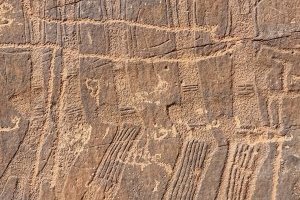
The rock paintings that you can visit are located in the town of Jubbah. The settlement itself is a very nice village with many buildings in the traditional style. I rented a car at the Hail Airport and drove 1.5 hours to the Visitor Center, located on the outskirts of Jubbah. The first thing that impresses is the surrounding landscape, it is simply amazing. Beautiful mountains surrounded by an endless desert.
At the Visitor Center, I was greeted with coffee and dates. After a short tour with three videos, you can go to see the inscriptions. Right next to the center are two mountains literally filled with them, it is simply impossible to tear yourself away. It took me more than an hour to climb them all.
After these two mountains, I advise you to return to the Visitor center and ask to open another gate to see the famous cart which is exactly like the carts from Val Camonica WHS in Lombardy (Italy). This fact is really impressive!
The second gate is a three-minute drive from the Visitor center. After viewing the cart, I advise you not to leave the gate, but to walk along the internal pedestrian road towards the Visitor center back. And here a real surprise awaits. On one of the rocks you will find a real treasure: humanoid figures from the late Paleolithic era. This is the best thing I have seen here. And in the Visitor center there is not a …
Keep reading 0 comments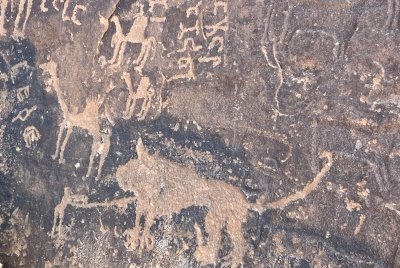
To see the rock art, we headed north from Buraydah, through the town of Ha'il to the smaller resort of Jubbah. There are two sites for the rock art: Jabal Umm Siman in Jubbah, where we went, and the slightly more remote Jabal Al-Manjor/Jabal Raat double site. Jubbah is also one of the smaller towns in the northern part of Saudi Arabia. There are a few signs pointing from the main road towards a place with rock paintings, but the end of the road has to be navigated using any of the online or offline maps.
Although the map has pointed us towards the museum and the place with the petroglyphs, on the way we saw another site with something obviously there: there was a staircase attached to the stones, the whole place was fenced off, and workers were just putting up an information board in front of the entrance. A gentleman who appeared to be the head of this shift spoke to us in English, welcomed us and explained that the museum and the main petroglyphs were about a kilometre further down the road, but that we could go and see these if we wanted to. So we did. The stairs led us to a stone with images carved into it.
We continued towards the museum is probably a bold designation for the administration building for the caretakers who open and close the gates to the main set of rock formations, with paths and sometimes stairs leading …
Keep reading 0 comments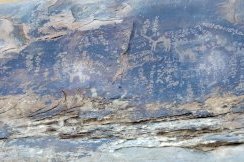
We also visited the Jubbah section of the rock art in early Feb 2020. It is an easy day trip from Hail and we went on a friday afternoon. Note that the site is only open after ~3pm on fridays but can be visited in the morning also during the rest of the week. Having found the place more easily than we thought, we arrived a little after 2pm and sat in the deserted parking lot unsure if it would really open for only a couple hours. Sure enough it did but in the worst case scenario it is possible to see a few of the petroglyphs through the fence in all else fails.
There were maybe a dozen visitors in total including one small tour group. A surly guard opened the gate and waved us through without any offer of guides or anything. This was the biggest mistake on our part. Inside there is a path that circles rock formations covered with petroglyphs but no information explaining what we were seeing. There was much more rock art than I'd been expecting but which ones were 10000, 5000 or 2000 years old? I can see and intuitively understand animals and early writing but I'd probably be more inclined to give the site more stars if I'd had more explanation. No doubt further development of the site is planned and if their Vision 2030 comes to fruition, more restrictions will be necessary as well. It made me cringe to see …
Keep reading 0 comments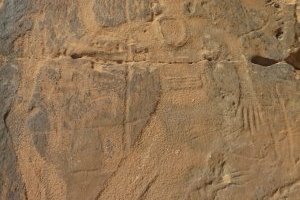
Hail Rock Art is one of the easier places to visit in the Kingdom. I wanted to come a day earlier but got stuck on a road leading into the dessert which I guess I wouldn't know without reading an Arabic sign or there wasn't a sign and they assume everyone will pass this area with a 4WD. No point in talking about it more but if you are coming from the southwest you have to get to Hail first, then turn west. If you are coming from Riyadh then it's clear how to drive anyway.
There are two locations, one in the far south of Hail but it's in the middle of nowhere so the choice was clear: Jubbah. I also inquired at the National Museum in Riyadh about a permit and they told me to find someone in Hail but actually that's not true. I think the term “permit” in the KSA means more like “get an official guide who arranges everything”.
So I got to the Jubbah site in the morning and the signs are very clear to find it. There was a huge tourist bus with a few Asian tourists standing nearby and I thought after a week of no foreigners I would get hit by an annoying tour bus from SE Asia or something but it turns out it was just 5 friendly Thai guests and their tour guide uses the massive bus for any tour group size. I walked into the administration …
Keep reading 0 comments
